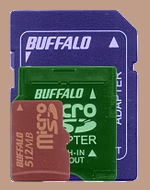1.1 Categorize storage devices and backup media
Storage media holds the data being accessed, as well as the files the system needs to operate, and the data that needs to be saved. The many different types of storage differ in terms of their capacity, access time, and the physical type of media used.
Though rapidly becoming obsolete, floppy disk drives may be found in some legacy systems and are often still used for archival applications. The most recent configuration accepted a removable 3 1/2" disk with a storage capacity of 1.44 MB and were traditionally assigned drive letters A and B.
Typically, a floppy disk drive is installed into a 3 1/2" drive bay. Data is transferred to and from the motherboard through a keyed 34-pin flat ribbon cable and power to the drive is provided by a 4-pin polarized Berg connector.
- HDD
Hard disk drives are sealed units typically mounted inside the computer, providing permanent storage and quick access. They store information either on small disks called platters or in integrated memory chips. The read and write operations of the drive are managed by the controller while data is transferred to and from the motherboard by the host adapter, which is usually integrated onto the motherboard.
Desktop hard drives come in a 3.5-inch form factor and require both 5V and 12V power from the power supply. Both ATA and SCSI drives have been widely used, but the most popular varieties are PATA and SATA.
- Magnetic Drives
- Lower Cost
- Very little heat produced
- Capable of higher storage capacity
- Solid state (e.g. thumb drive, flash, SD cards, USB)
- Uses memory to store data
- Contains no moving parts, quieter
- Resistant to shock and vibration
- Faster read/write speeds
- Lower power consumption
There are three primary types of optical storage media in use today. Compact Discs (CD), Digital Versatile Discs (DVD), and Blu-Ray discs. Data is recorded to this type of media by stamping irregularities onto the surface of the disc, or "burned" into it using a laser, in a spiral pattern that runs from the inside to the outside of the disk. The data is read back from the disc using a laser. Differences in reflection caused by the variations in the plastic layer are detected and translated as 0s and 1s.
Most internal drives are designed to fit in a standard 5.25" drive bay. Internal connections may be provided by either a PATA or SATA interface and may require additional outputs to the sound card or the motherboard for audio.
- CD (Compact Disc)
Used for digital data storage, Standard CDs have a diameter of 120 millimetres (4.7 in) and can hold up to 80 minutes of uncompressed audio or 700 MB (700 × 220 bytes) of data. Formats include read-only (CD-ROM), write-once audio and data storage (CD-R), and rewritable media (CD-RW).
- DVD
- 4.7GB capacity(single-sided/single-layer)
- 8.5GB capacity (single-sided/double-layer)
- 9.4GB capacity (double-sided/single-layer)
- 17.1GB capacity (double-sided/double-layer)
- RW
CD-R and CD-R/RW recorders employ several different writing modes. Not all recorders and software support every writing mode.
- Blu-Ray
- High-density optical disc
- 25-50GB storage capacity single-layer
- 50-100GB storage capacity dual-layer
- Removable storage
- Tape drive
- Can be installed internally or externally
- Uses either digital or analog magnetic tape
- 100GB capacity / 200GB compressed
- Slower than most medium
- Primarily used for archives
- Solid state
- Thumb Drive
Also known as a jump drive or flash drive, a convenient means for data transfer quickly replacing the traditional floppy disk drive. Equipped with a hot-swappable USB interface
- Flash Drives
Commonly used in portable devices, Flash Drives or CompactFlash Cards are found in two form factors:
- Type I (3.3 mm thick)
- Type II (5 mm thick)
- SD cards
Secure Digital (SD) is a non-volatile memory card format developed for use in portable devices.
SD comprises several families of cards:
- The original, Standard-Capacity (SDSC) card
- High-Capacity (SDHC) card
- eXtended-Capacity (SDXC) card
- SDIO with input/output functions
SD cards are found in several form factors:
- Standard (32 mm × 24 mm)
- Mini (21.5 mm × 20 mm)
- Micro (15 mm × 11 mm)
- xD Picture Card (20 mm × 25 mm)
 
Electrically passive adaptors allow the use of a smaller card in a host device built to hold a larger card.
- USB
USB (Universal Serial Bus) drives, which include Thumb drives and Flash Drives, are composed of a controller with a USB interface, non-volatile memory, and an LED light to indicate drive activity. Many are equipped with encryption and password protection capabilities.
USB devices are supported by Windows 2000 Professional, Windows XP, Vista, and Windows 7 and should only be removed by running the Safely Remove Hardware utility before unplugging the device.
- External CD-RW and hard drive
Provides portable storage with popular interfaces of USB and FireWire. Some are available with an eSATA or SCSI interface and some still require additional power sources.
- Hot swappable devices and non-hot swappable devices
Hot swappable devices can be added or removed from your computer without having to reboot. USB devices, keyboard, mouse, thumb drives, are common examples as well as some SATA hard drives. RAID disk arrays are also configured to be hot swappable to permit the replacement of a failed drive without having to disable the system. Devices that require rebooting or need to have drivers installed to operate are considered non-hot swappable.
|